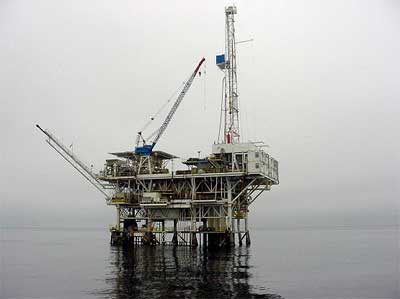Pipe Dreams Set to Become Reality
Venoco Clears Last Obstacle to Ditch Barge

Thanks in no small part to decades’ worth of Santa Barbara-based vigilance, the last oil barge operation off of California’s shore will soon come to an end.
Clearing its final regulatory hurdle last week at the California Coastal Commission (CCC), Venoco Inc.’s long-stewing plan to replace the large barge that regularly connects Ellwood Oil Field’s Platform Holly — just two miles offshore of Coal Oil Point in Goleta — to refineries from Long Beach to San Francisco with a pipeline will officially begin construction later this fall.
“Really, since the ‘80s, every time there has been a new operator [at Platform Holly] we have been trying to get them to use a pipeline infrastructure,” explained the Environmental Defense Center’s Linda Krop in the wake of the CCC’s vote. “This is very historic.”
The pipeline plan, which was approved by both the Santa Barbara County Board of Supervisors and the Goleta City Council last month, will create roughly eight-and-a-half new miles of onshore pipe, connecting the Ellwood terminal adjacent to Sandpiper Golf Course to the Exxon facility up coast in Gaviota’s Las Flores Canyon.
The crude, once at Las Flores, will then be able to tie into existing pipes and be sent to refineries up and down the coast as well as inland. Construction on the new pipeline — which, it should be noted, will by and large be sited on existing roads and easements with special attention given to habitat restoration and spill safety protocols — is scheduled to begin on October 1.
The news comes as a major victory for South Coast-centered organizations like Get Oil Out, the Citizens Planning Association, the Los Padres Sierra Club, and Citizens for Goleta Valley — all of whom advocated for the conversion of barge to pipeline, and had hired the EDC to do the legal lifting necessary to help make the switch a reality.
For them, the monthly trips of the Olympic Spirit (Venoco’s double-hulled barge) up and down most of the California coast with thousands of gallons of crude on board, was an increasingly outdated and intolerable spill risk that was made ever worse when considering the air emission issues associated with it. “It may only be eight-and-a-half miles of pipeline,” summed up Krop, “but we are actually protecting most of the state’s coast by eliminating the barge.”
For Venoco, the switch also makes sense. Once the pipeline is finished and contracts are in place, the company estimates it will generate roughly $5 to $7 of additional revenue per barrel of oil on the roughly 2,000 barrels of crude it harvests per day from the Ellwood Field, thanks to no longer having to subsidize the Spirit.
Furthermore, the 30-year lease from the state that permits the barging practice is set to expire in 2013 and, by all accounts, the approval process for a new one would have been, at the very least, an uphill battle.
Construction on the pipeline is tentatively slated to conclude in late February/early March, with the new mode of oil transport going live sometime next spring.



